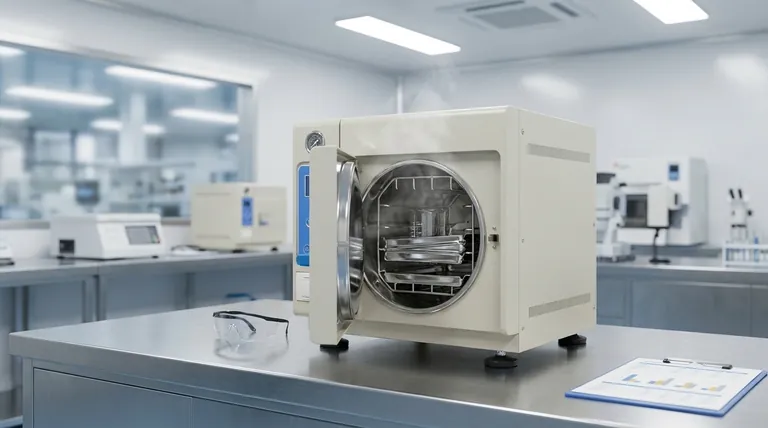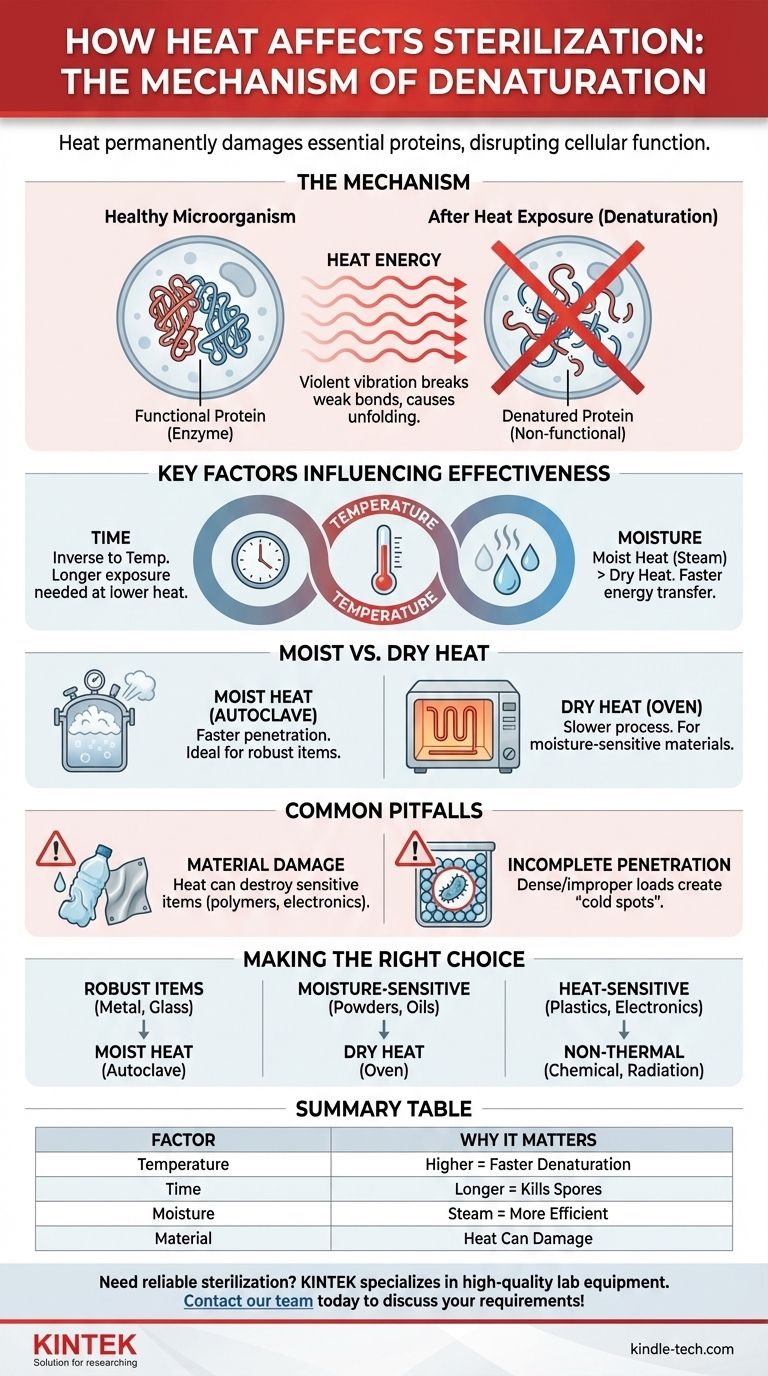Simply put, heat kills microorganisms by permanently damaging their essential proteins. This process, known as denaturation, disrupts the proteins' structure and function, much like cooking an egg turns the white from a clear liquid into an opaque solid. Once critical proteins are denatured, the microorganism's cellular machinery breaks down, and it can no longer survive or reproduce.
The core principle is that heat transfers energy into a microorganism, causing its vital proteins and enzymes to unfold and lose their shape. This irreversible damage is lethal, making heat one of the most reliable and widely used methods for sterilization.

The Mechanism of Thermal Sterilization
To understand why heat is so effective, you have to look at the molecular level. A microorganism is a complex system that relies on thousands of precisely shaped proteins to function.
The Critical Role of Proteins
Proteins are the workhorses of any cell. They are responsible for everything from providing structural integrity to catalyzing the chemical reactions necessary for life (as enzymes).
A protein's function is entirely dependent on its unique, complex three-dimensional shape.
Denaturation: The Point of No Return
Heat introduces energy that causes the atoms within the protein to vibrate violently. This vibration breaks the weak bonds that hold the protein in its specific functional shape.
The protein unravels and loses its structure in a process called denaturation. This damage is almost always permanent.
Once a cell's essential proteins and enzymes are denatured, it can no longer metabolize, repair itself, or replicate. The cell is effectively dead.
Key Factors Influencing Effectiveness
Sterilization isn't just about turning up the heat; it's a carefully controlled process where several factors determine success or failure.
Time and Temperature
There is an inverse relationship between time and temperature. Higher temperatures can achieve sterilization in a much shorter period.
Conversely, lower temperatures require a significantly longer exposure time to ensure all microorganisms, including resilient spores, are eliminated.
Moist Heat vs. Dry Heat
The presence of water dramatically impacts efficiency. Moist heat (steam) is far more effective at sterilization than dry heat.
Water molecules help to transfer heat energy more efficiently into the cells and play a direct role in breaking the bonds within proteins, accelerating denaturation. This is why an autoclave, which uses pressurized steam, is a gold standard in medical and laboratory settings.
Common Pitfalls and Limitations
While powerful, heat sterilization is not a universal solution. Its primary limitation is the potential for collateral damage to the item being treated.
Damage to Materials
The very energy that destroys microbes can also destroy the object you are trying to sterilize. High temperatures can melt plastics, warp delicate instruments, or degrade sensitive chemical compounds.
This makes heat sterilization unsuitable for many polymers, electronics, and certain pharmaceuticals.
Incomplete Penetration
For sterilization to be effective, the heat must penetrate the entire object and reach every surface. Dense or improperly packaged items may have "cold spots" where microorganisms can survive.
This is why proper loading of an autoclave or sterilizer is critical to ensure steam or hot air can circulate freely.
Making the Right Choice for Your Application
Selecting the correct sterilization method requires balancing effectiveness against the nature of the material being sterilized.
- If your primary focus is sterilizing robust, heat-resistant items (like metal surgical tools or glassware): Moist heat sterilization via an autoclave is the fastest and most reliable method.
- If your primary focus is sterilizing materials sensitive to moisture (like powders, oils, or some metal instruments prone to rust): Dry heat sterilization is the appropriate choice, but you must account for longer cycle times and higher temperatures.
- If your primary focus is sterilizing heat-sensitive items (like most plastics, fiber optics, or electronics): You must use non-thermal methods such as chemical sterilization (ethylene oxide), radiation, or filtration.
Ultimately, understanding the mechanism of heat sterilization empowers you to apply it effectively and to recognize precisely when it is not the right tool for the job.
Summary Table:
| Factor | Why It Matters |
|---|---|
| Temperature | Higher temperatures cause faster, more effective protein denaturation. |
| Time | Longer exposure ensures all microorganisms, including spores, are killed. |
| Moisture | Steam (moist heat) transfers energy more efficiently than dry heat. |
| Material | Heat can damage sensitive items like plastics or electronics. |
Need a reliable sterilization solution for your lab? The right equipment is critical for effective and safe sterilization. KINTEK specializes in high-quality lab equipment, including autoclaves for moist heat sterilization and ovens for dry heat processes. Our experts can help you select the perfect system to meet your specific application needs, ensuring both efficacy and material compatibility. Contact our team today to discuss your laboratory's sterilization requirements!
Visual Guide

Related Products
- Desktop Fast Laboratory Autoclave Sterilizer 35L 50L 90L for Lab Use
- Desktop Fast Laboratory Autoclave Sterilizer 20L 24L for Lab Use
- Laboratory High Pressure Steam Sterilizer Vertical Autoclave for Lab Department
- Portable Digital Display Automatic Laboratory Sterilizer Lab Autoclave for Sterilization Pressure
- Laboratory High Pressure Horizontal Autoclave Steam Sterilizer for Lab Use
People Also Ask
- What is the temperature of autoclave in microbiology lab? Achieve Sterile Conditions with 121°C
- What is an autoclave laboratory equipment? The Ultimate Guide to Steam Sterilization
- What is an autoclave used for in a lab? Achieve Total Sterilization for Lab Safety and Integrity
- Which autoclave is used in microbiology lab? Gravity Displacement vs. Pre-Vacuum Explained
- What are the different types of autoclaves in microbiology? Gravity vs. Pre-Vacuum Explained



















